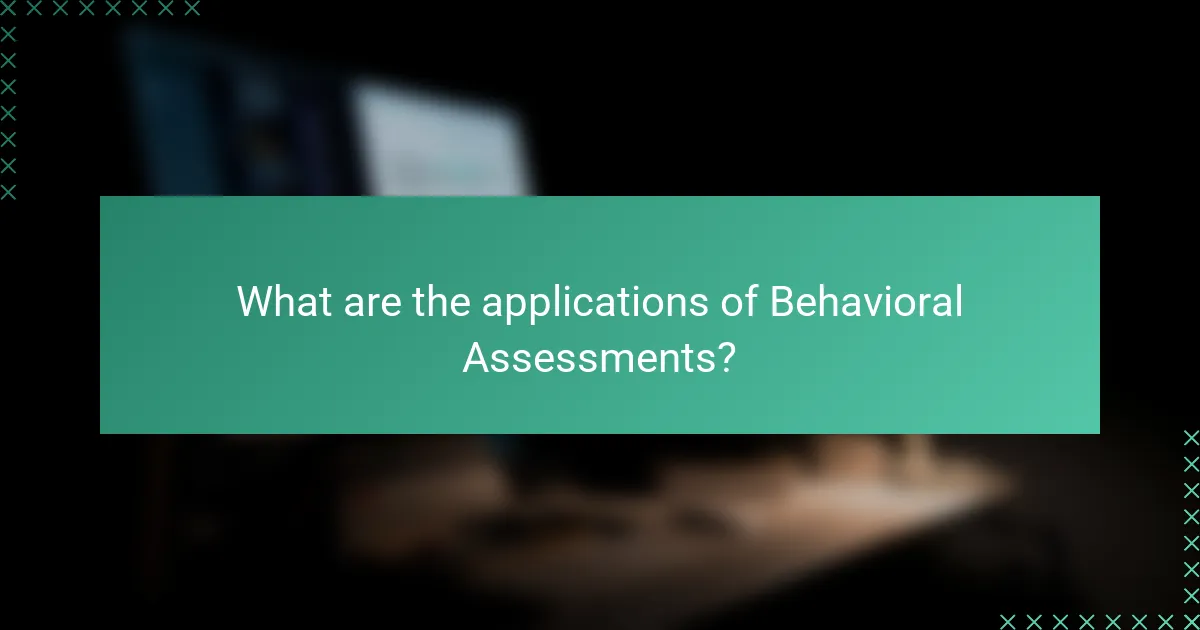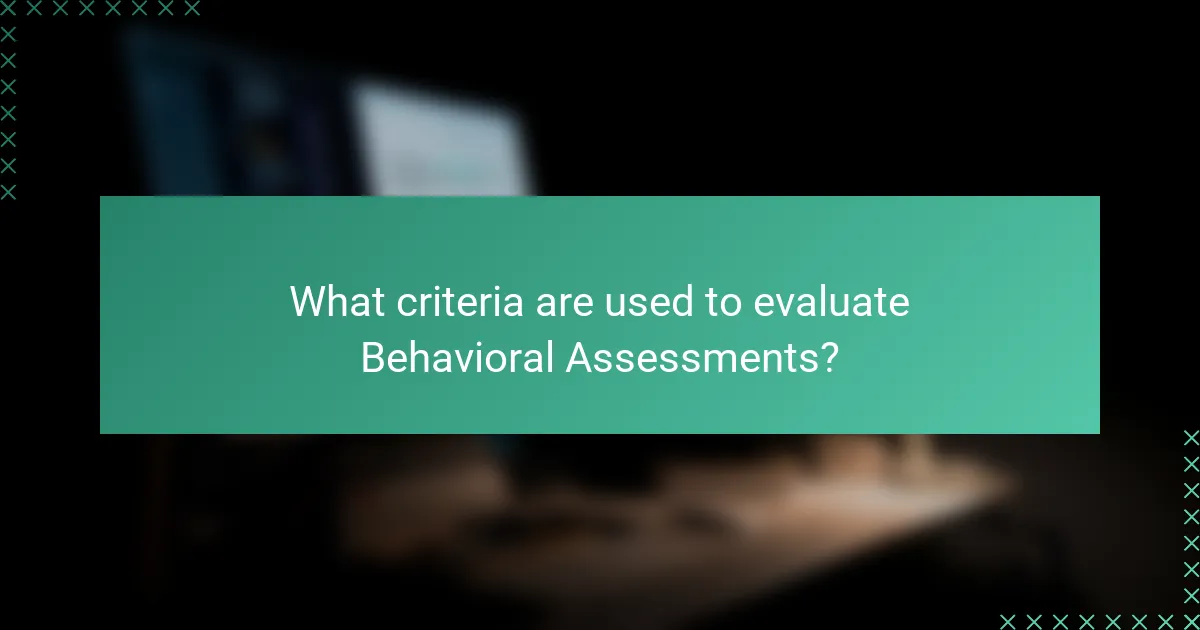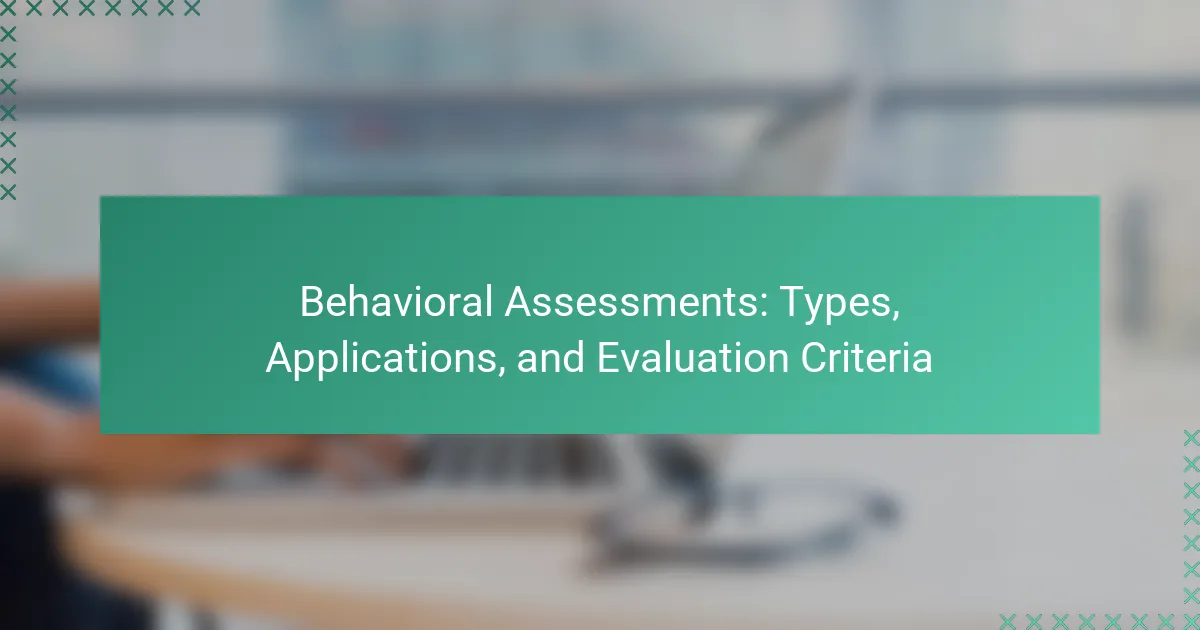Behavioral assessments are systematic evaluations designed to measure and understand an individual’s behavioral patterns, traits, and skills. These assessments utilize standardized tests, observations, and self-reports and are applicable in various contexts, including clinical psychology, education, and organizational settings. They help identify strengths and weaknesses, inform personalized interventions, and improve outcomes in mental health and educational environments. The effectiveness of behavioral assessments is evaluated based on criteria such as reliability, validity, practicality, and cultural fairness, ensuring their appropriate application across diverse populations. This article will explore the types, applications, and evaluation criteria of behavioral assessments, highlighting their significance in decision-making processes.

What are Behavioral Assessments?
Behavioral assessments are systematic evaluations of an individual’s behavior. These assessments aim to understand and measure behavioral patterns, traits, and skills. They often involve standardized tests, observations, and self-reports. Behavioral assessments can be used in various settings, including educational, clinical, and organizational contexts. They help identify strengths and weaknesses in behavior. Additionally, these assessments can inform interventions and support strategies. Research shows that behavioral assessments can improve outcomes in mental health and educational settings. For instance, studies indicate that they enhance personalized treatment plans.
How do Behavioral Assessments function?
Behavioral assessments function by evaluating an individual’s behavior through standardized methods. These methods typically include questionnaires, interviews, and observational techniques. They aim to identify behavioral patterns, strengths, and areas for improvement. Behavioral assessments often utilize rating scales to quantify behaviors. This quantification allows for objective comparisons across different individuals. They can be used in various settings, including clinical, educational, and organizational contexts. Research shows that structured behavioral assessments can predict future behaviors effectively. For instance, a study published in the Journal of Applied Psychology found that behavioral assessments correlate with job performance outcomes.
What are the key components of Behavioral Assessments?
Key components of behavioral assessments include observation, interviews, and standardized tests. Observation involves monitoring an individual’s behavior in various settings. This provides real-time data on actions and reactions. Interviews gather subjective insights from individuals or caregivers about behaviors and experiences. Standardized tests offer quantifiable measures of behavioral traits and patterns. These components collectively help in understanding an individual’s behavior comprehensively. Research shows that combining these methods enhances the accuracy of behavioral assessments.
How do these components contribute to the assessment process?
Components such as observation, interviews, and standardized tests contribute significantly to the assessment process. Observation allows evaluators to gather real-time data on behaviors in natural settings. Interviews provide qualitative insights and context from individuals involved. Standardized tests offer quantifiable metrics that can be compared across populations. Together, these components create a comprehensive picture of an individual’s behavioral patterns. Research shows that combining multiple assessment methods increases reliability and validity (American Psychological Association, 2013). This multifaceted approach ensures that the assessment process is thorough and accurate.
What types of Behavioral Assessments exist?
There are several types of behavioral assessments. These include observational assessments, self-report questionnaires, and performance-based assessments. Observational assessments involve watching individuals in real-life situations to evaluate their behavior. Self-report questionnaires ask individuals to describe their own thoughts and behaviors. Performance-based assessments require individuals to complete tasks that demonstrate their behavioral skills. Each type serves different purposes in understanding behavior. For example, observational assessments provide context, while self-reports offer personal insights. Performance-based assessments can measure specific skills in action.
What are the differences between formal and informal assessments?
Formal assessments are structured evaluations that follow standardized procedures. They typically include tests, quizzes, and standardized exams. These assessments measure specific knowledge or skills and provide quantifiable data. Informal assessments, on the other hand, are unstructured and often occur in natural settings. They include observations, discussions, and anecdotal records. Informal assessments focus on the learning process and provide qualitative insights. The primary difference lies in structure and purpose. Formal assessments aim for reliability and validity, while informal assessments prioritize flexibility and context.
How do self-report and observer-report assessments compare?
Self-report assessments involve individuals evaluating their own thoughts and feelings. Observer-report assessments involve third parties evaluating an individual’s behavior and characteristics. Self-report assessments can provide insights into personal experiences and subjective feelings. However, they may be influenced by biases such as social desirability. Observer-report assessments can offer an objective perspective on behavior. They often capture information that the individual may overlook or misinterpret. Research indicates that both methods can yield different results. For example, a study by Connelly and Ones (2010) found discrepancies between self-reported and observer-reported personality traits. This suggests that combining both assessments can provide a more comprehensive understanding of an individual’s behavior.

What are the applications of Behavioral Assessments?
Behavioral assessments have various applications across multiple fields. They are used in clinical psychology to diagnose mental health conditions. In educational settings, these assessments help identify learning disabilities and behavioral issues in students. Organizations utilize behavioral assessments for employee selection and development. They assist in understanding team dynamics and improving workplace relationships. Additionally, behavioral assessments are applied in therapy to tailor interventions for individual needs. They can also be used in research to study behavioral patterns in different populations. Overall, behavioral assessments provide valuable insights that inform decision-making in diverse contexts.
How are Behavioral Assessments used in educational settings?
Behavioral assessments are used in educational settings to evaluate students’ behavior and emotional functioning. These assessments help identify students who may need additional support. They can be used to develop individualized education plans (IEPs) for students with special needs. Behavioral assessments also guide interventions aimed at improving student behavior. Tools such as rating scales and observations are commonly utilized. Research shows that early identification through behavioral assessments can lead to better academic outcomes. Studies indicate that students receiving appropriate interventions based on assessment results show significant improvement in behavior and learning.
What are the benefits of using Behavioral Assessments in schools?
Behavioral assessments in schools provide valuable insights into student behavior. They help identify students’ social-emotional needs. This identification allows for targeted interventions. Such interventions can improve academic performance. Additionally, behavioral assessments foster better communication between educators and parents. They create a comprehensive understanding of a student’s behavior in various contexts. Research shows that schools using behavioral assessments report fewer disciplinary issues. This leads to a more positive learning environment.
How do educators implement these assessments effectively?
Educators implement assessments effectively by aligning them with learning objectives. They begin by clearly defining the goals of the assessment. Next, they select appropriate assessment types, such as formative or summative assessments. Educators also ensure that assessments are valid and reliable. This involves using established criteria to measure student performance accurately. Additionally, they provide clear instructions and criteria for success to students. They analyze assessment data to inform instruction and adapt teaching strategies. Continuous feedback is crucial for student improvement and engagement. Regularly reviewing and refining assessment methods enhances their effectiveness over time.
What role do Behavioral Assessments play in the workplace?
Behavioral assessments play a critical role in the workplace by evaluating employees’ behaviors, skills, and personality traits. These assessments help organizations identify suitable candidates during the hiring process. They also assist in employee development by highlighting areas for improvement. Furthermore, behavioral assessments can enhance team dynamics by understanding individual strengths and weaknesses. Research shows that companies using behavioral assessments report higher employee satisfaction and retention rates. For example, a study by the Society for Human Resource Management found that organizations using such assessments experienced a 30% increase in employee engagement. This demonstrates the effectiveness of behavioral assessments in fostering a productive work environment.
How can Behavioral Assessments enhance employee selection?
Behavioral assessments enhance employee selection by providing insights into candidates’ personality traits and behaviors. These assessments evaluate how individuals may react in various work situations. They help employers identify candidates whose behaviors align with organizational culture and job requirements. Research shows that behavioral assessments can predict job performance more accurately than traditional interviews. A study published in the Journal of Applied Psychology found that behavioral assessments improve hiring success rates by 25%. This data supports the effectiveness of using behavioral assessments in the selection process.
What impact do they have on team dynamics and performance?
Behavioral assessments positively impact team dynamics and performance. They enhance communication by identifying individual strengths and weaknesses. This clarity fosters better collaboration among team members. Improved understanding leads to increased trust and reduced conflicts. Research shows that teams with clear behavioral insights perform 25% better in project outcomes. Behavioral assessments also promote tailored development plans, enhancing individual contributions. This personalized approach boosts overall team morale and engagement. Ultimately, effective behavioral assessments create a more cohesive and high-performing team environment.

What criteria are used to evaluate Behavioral Assessments?
Behavioral assessments are evaluated based on several criteria. These include reliability, validity, and practicality. Reliability refers to the consistency of results across different instances of the assessment. Validity measures how well the assessment captures the intended behavioral constructs. Practicality involves the ease of administration and interpretation of results. Additionally, cultural fairness is essential to ensure assessments are appropriate across diverse populations. Each of these criteria helps determine the effectiveness and applicability of behavioral assessments in various contexts.
What makes a Behavioral Assessment reliable and valid?
A reliable and valid behavioral assessment consistently measures what it intends to measure. Reliability refers to the consistency of results over time and across different contexts. Validity assesses whether the assessment accurately reflects the construct it aims to evaluate. For example, a behavioral assessment should yield similar results when administered to the same individual on different occasions, demonstrating test-retest reliability. Additionally, the assessment must correlate with established measures of the same construct, indicating concurrent validity. Research shows that well-constructed assessments, such as the Behavior Assessment System for Children (BASC), exhibit both high reliability and validity, making them effective tools in clinical and educational settings.
How do reliability and validity affect assessment outcomes?
Reliability and validity significantly influence assessment outcomes. Reliability refers to the consistency of an assessment tool. High reliability means that the tool produces stable results over time. Validity indicates whether the assessment measures what it claims to measure. High validity ensures that the results accurately reflect the intended construct.
When an assessment lacks reliability, it can yield fluctuating results. This inconsistency can lead to misguided conclusions about an individual’s abilities or behaviors. For example, a test with low reliability may score a person differently on repeated attempts, causing confusion.
Conversely, if an assessment is reliable but not valid, it may consistently measure the wrong construct. This scenario can lead to a false sense of confidence in the results. For instance, a reliable test that measures anxiety may not accurately assess depression, resulting in ineffective interventions.
Research shows that both reliability and validity are crucial for effective assessments. According to the Standards for Educational and Psychological Testing, reliable assessments contribute to valid interpretations. Therefore, both attributes must be evaluated to ensure accurate assessment outcomes.
What are the standards for ethical considerations in Behavioral Assessments?
The standards for ethical considerations in behavioral assessments include respect for individuals, informed consent, confidentiality, and fairness. Respect for individuals emphasizes dignity and worth. Informed consent requires clear communication about the assessment’s purpose and procedures. Confidentiality safeguards personal information from unauthorized access. Fairness ensures assessments are free from bias and culturally sensitive. These standards are established by professional organizations such as the American Psychological Association. They guide practitioners in conducting assessments ethically and responsibly.
How can one choose the right Behavioral Assessment tool?
To choose the right Behavioral Assessment tool, identify the specific needs of your organization. Consider the type of behavior you want to assess, such as personality traits, cognitive abilities, or emotional intelligence. Evaluate the validity and reliability of the tools available. Research tools with proven track records and positive user feedback. Ensure the tool aligns with your organizational goals and culture. Review the ease of administration and interpretation of results. Lastly, consider the cost and resources required for implementation. These steps ensure that the selected tool effectively meets your assessment objectives.
What factors should be considered when selecting an assessment tool?
Factors to consider when selecting an assessment tool include reliability, validity, and usability. Reliability refers to the consistency of the tool’s results over time. Validity assesses whether the tool measures what it claims to measure. Usability involves how easy the tool is to administer and interpret. Additionally, cultural relevance is crucial to ensure the assessment is appropriate for the target population. Cost-effectiveness also plays a role, as budget constraints can limit options. Finally, the tool’s alignment with specific goals or objectives of the assessment process is essential for effective outcomes.
How can practitioners ensure the tool meets their specific needs?
Practitioners can ensure the tool meets their specific needs by conducting a thorough needs assessment. This involves identifying the specific objectives and requirements of their practice. Practitioners should evaluate the tool’s features against these requirements. They can also seek feedback from colleagues who have used the tool. Additionally, practitioners should review case studies or research that demonstrate the tool’s effectiveness in similar contexts. Ensuring compatibility with existing systems is crucial for seamless integration. Regularly updating the tool based on user feedback further enhances its relevance. By following these steps, practitioners can align the tool’s capabilities with their unique needs.
What best practices should be followed in conducting Behavioral Assessments?
Best practices for conducting behavioral assessments include clear objectives, standardized procedures, and trained personnel. Establishing clear objectives ensures that the assessment targets specific behaviors and outcomes. Standardized procedures enhance reliability and validity, allowing for consistent results across different assessors. Trained personnel are essential as they can accurately administer assessments and interpret results. Additionally, using multiple assessment methods provides a comprehensive view of behavior. Incorporating feedback from multiple sources, such as parents and teachers, enriches data quality. Regularly reviewing and updating assessment tools keeps them relevant and effective. Finally, ensuring confidentiality and ethical standards maintains trust and integrity in the assessment process.
Behavioral assessments are systematic evaluations designed to understand and measure individual behaviors, traits, and skills through standardized methods such as tests, observations, and self-reports. This article covers the various types of behavioral assessments, including observational, self-report, and performance-based assessments, as well as their applications in educational, clinical, and organizational settings. Key components of these assessments, such as reliability, validity, and ethical considerations, are discussed to highlight their importance in accurately evaluating behavior. Furthermore, best practices for conducting effective behavioral assessments are outlined to ensure optimal outcomes across different contexts.
